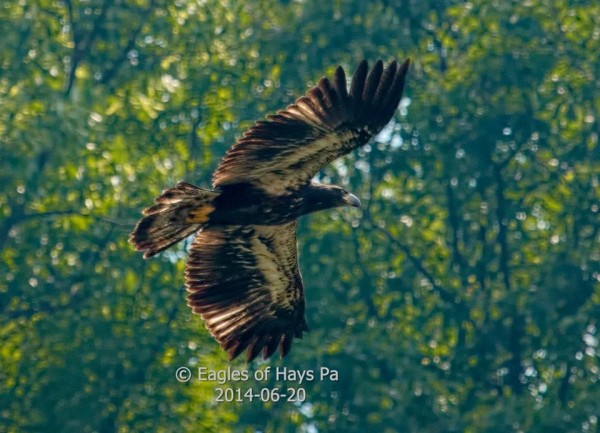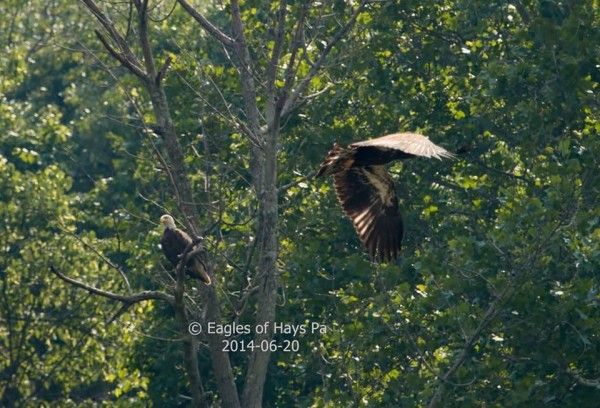Dear Readers, there’s nothing like an in-person visit to correct a beautifully written but inaccurate story. This morning I wrote that #3 had flown but I confused #3 with H3. My original incorrect story follows. Watch for the correction(**) at the end!
He hatched last and flew first! (**)
Yesterday morning the three Hays eaglets were still walking up and down the branches near their nest and testing their wings (click here for video). At 10:14am one left the nest but no one saw where it went. Then at 1:20pm that eaglet flew! And guess what …drumroll… the first to fly was Eaglet#3, the smallest and last to hatch. (** ummm. no. See note at end!)
In early April we worried that #3 might not make it because he was so small and his oldest sibling bopped him on the head whenever his parents brought in food. But #3 proved to be a tough little bird who could “elbow” his siblings out of the way and get his share first.
As they grew we figured out that #3 is smallest because he’s male and his siblings are female. This gave him First Flight advantage because he’s more maneuverable than his bigger, heavier sisters.
Yesterday at the Eagle Watch, Dana Nesiti was ready with his camera in case one of the eaglets flew. At 1:20pm a young eagle went airborne and Dana captured it all.
The juvenile’s first landing was on the ground (uh oh!) but he got up and flew again, this time right past his mother. Great shot, Dana!
Congratulations, #3! And thank you, Dana Nesiti, for sharing your photos!
See more of the first flight and great eagle photos at Eagles of Hays PA.
Visit the Hays Eagle Watch today and see the eagles in person. Click here for directions.
Wooo hooo!
(photos by Dana Nesiti, Eagles of Hays PA)
(**) CORRECTION at 9:00pm!
I went down to the Eagle Watch this afternoon and learned my mistake. The watchers are as certain as they can be that the first to fledge is one of the two females. Most say it was “H3.”
H3 means “3rd to Hatch” but in eagle terminology it’s “3rd hatch of this mother” not “3rd hatch this year.” H1 was last year’s solo juvenile, H2 is this year’s first female, H3 is the 2nd female, H4 is the male.
This terminology is foreign to me, a veteran peregrine watcher. Peregrine eggs hatch all at once so it’s impossible to identify the young by their hatch order and equally impossible to identify them by their birth order to the same mother.
So… This year’s male hasn’t flown yet. But he will soon. His sister H2 may have fledged today just before sunset. Stay tuned at Eagles of Hays PA and the Hays Eaglecam.
p.s. The Post-Gazette says the eaglet flew at 10:14am. This is because the bird left the nestcam view at 10:14am. She was not seen flying until 1:20pm.


Oh, thank you for the explanation. I wondered where they were getting these numbers, especially who H4 was. I thought maybe they were including the parents. Always good to keep learning.
Missed all the photos until today! Please send Kudos to Dana. I have questions.
1. Not educated about Eagles,how does one tell the birds apart, IE is the male smaller than the female?
2. When were the Eaglets given numbers, and how has it been determined than it was H3 that fledged first? Have they been “banded”?
Keirin, here are some answers…
1. Down at the Watch site on the Three Rivers Heritage Trail we can tell the male from the females because males are noticeably smaller. The dedicated Eagle Watchers have looked for distinguishing feather/color characteristics and some say they can tell the females apart. I cannot … and I don’t remember what clues the Watchers use.
2. The online Watchers gave the eaglets numbers and spent time keeping track of them. I’m sure there were many discussions about who was who & which one fledged first. No one can know for sure because none of the eagles (including the parents) are banded.
Thank you. I assume that since the adults are not banded that there is not a way for them to be safely captured and banded.(Not easy nor important.) Leave nature’s beauty alone!